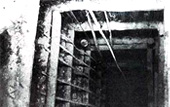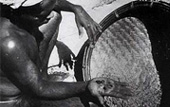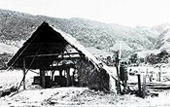One
of the world’s most beautiful and exotic islands,
Sri Lanka, (formerly Ceylon) lies just below the southern
tip of India. This pear-shaped bit of tropical paradise,
about the size of Sicily, is a tourist’s delight
offering British teahouses, rubber plantations, and
gem mines.
Marco Polo wrote of his visit in 1292:
“I want you to understand that the island of Ceylon
is, for its size, the finest island in the world, and
from its streams comes rubies, sapphires, topazes, amethyst
and garnet.” Little has changed since Marco Polo’s
time except that Sri Lanka faces overpopulation and
a faltering economy.
Its gemstones, however, seem to occur
in endless supply. Known as the “Jewel Box of
the Indian Ocean,” Sri Lanka, like possibly no
other locality on earth, has yielded precious stones
and fine gems in a great profusion of gem species and
varieties.
The island was known in the ancient
world as Taprobane (copper colored in Greek). Native
Veddahs, bathing in smooth flowing streams, noticed
colored pebbles scattered in sandy bottoms. It was not
until 500 B.C. that conquering Buddhists from northern
India also discovered gems in the rivers and began to
set rough stones into crude jewelry.
They bartered stones with traders from
abroad and eventually the treasures found their way
to the marketplaces of Asia and Europe. Ancient Greek
and Chinese historians referred to the beautiful gems
of Ceylon, and King Solomon reportedly wooed the Queen
of Sheba with Ceylonese precious stones.
 Geologically,
gemstones originated within a broad belt known as the
Highland Series which runs through the center of Sri
Lanka. The edges of the belt form a trough bordered
by chains of mountains and peaks. The trough, made up
of highly crystalline Precambrian metamorphosed rock,
featured components of schists, quartzite, marbles,
and sometimes pegmatite deposits. Rock erosion resulted
in the formation of extensive gem-laden placer deposits
along stream beds in lower valleys. Geologically,
gemstones originated within a broad belt known as the
Highland Series which runs through the center of Sri
Lanka. The edges of the belt form a trough bordered
by chains of mountains and peaks. The trough, made up
of highly crystalline Precambrian metamorphosed rock,
featured components of schists, quartzite, marbles,
and sometimes pegmatite deposits. Rock erosion resulted
in the formation of extensive gem-laden placer deposits
along stream beds in lower valleys.
Miners soon learned the richest deposits
were composed of blue and yellow clays called illam
which lay just below the surface of lush valley farmlands.
During their tortuous journey downstream, most gem crystals
were worn to rounded pebbles, but harder than host minerals,
they managed to retain much of their size.
Every available square meter of stream
bed was mined until all known gem areas were exhausted.
The miners discovered that the rivers they were working
were in reality “surface streams” and that
by digging downward from 7 to 30 meters, “ancient
streams” could be encountered. Unfortunately most
of the ancient streams lay beneath cultivated fields.
Prospecting and mining operations caused great destruction
to crops and created considerable animosity between
farmer and miner.
 Eventually
new mining methods were devised whereby the gem hunter
could operate at a profit and still leave the farmland
virtually intact. A vertical shaft was dug downward
until the illam was reached. Feeder tunnels extended
in a number of directions like the spokes on a wheel.
The shaft and tunnels were carefully supported by wood
and bamboo timbers. The miners dug along the tunnels,
loaded the gravel into knapsacks, and then climbed to
the surface with their loads. Washing, screening, and
sorting occurred on the surface. Usually pumps operated
full time to keep the tunnels free of water. When a
mine played out, the tunnels were closed off, the shaft
filled, the buildings removed, and new topsoil spread
over the area. As another growing season approached,
all vestiges of the mine vanished. Eventually
new mining methods were devised whereby the gem hunter
could operate at a profit and still leave the farmland
virtually intact. A vertical shaft was dug downward
until the illam was reached. Feeder tunnels extended
in a number of directions like the spokes on a wheel.
The shaft and tunnels were carefully supported by wood
and bamboo timbers. The miners dug along the tunnels,
loaded the gravel into knapsacks, and then climbed to
the surface with their loads. Washing, screening, and
sorting occurred on the surface. Usually pumps operated
full time to keep the tunnels free of water. When a
mine played out, the tunnels were closed off, the shaft
filled, the buildings removed, and new topsoil spread
over the area. As another growing season approached,
all vestiges of the mine vanished.
In 1974 when the author visited Sri
Lanka, the Pelmadulla mine was in operation about 15
kilometers west of Ratnapura. It proved to be a good
producer of white and cornflower-blue sapphires. Like
all gem gravel mines on the island, when the Pelmadulla
was worked out, its shafts were filled, its sumps removed,
and rice was planted over the old workings. Today it
might be impossible to locate the old mine site.
 Ratnapura
(Singhalese for ‘gem town’) lies about 100
kilometers southeast of Colombo. Its mining region has
produced an incredible variety of gemstones, many of
them outstanding in comparison with stones from other
regions. Sapphire occurs in all hues of blue, as well
as yellow, violet, green, pink, and the remarkable pinkish-orange
“padparadsha.” Other gemstones include topaz
in bright yellow with a reddish tinge; brownish yellow
to cinnamon-colored grossular; orange-yellow spessartine;
blood-red pyrope; red to brownish red almandine; the
world’s finest zircon in a broad spectrum including
brown, yellow, orange, green, and colorless (known locally
as ‘Matara diamond’– a misnomer);
green, yellow, and brown tourmaline; yellow, green,
and brown chrysoberyl; yellow chrysoberyl cat’s-eye;
the unique white translucent variety of microcline with
a blue sheen known as moonstone; and great quantities
of spinel in brown, green, blue, purple, violet, yellow,
pink, and red. Unusual and rare stones from the same
area include sillimanite, andalusite, scapolite, enstatite,
kornerupine, diopside, and sinhalite. Recently a 5000-carat
cat’s-eye chrysoberyl, the size of a man’s
fist, was taken from a mine near Ratnapura. Ratnapura
(Singhalese for ‘gem town’) lies about 100
kilometers southeast of Colombo. Its mining region has
produced an incredible variety of gemstones, many of
them outstanding in comparison with stones from other
regions. Sapphire occurs in all hues of blue, as well
as yellow, violet, green, pink, and the remarkable pinkish-orange
“padparadsha.” Other gemstones include topaz
in bright yellow with a reddish tinge; brownish yellow
to cinnamon-colored grossular; orange-yellow spessartine;
blood-red pyrope; red to brownish red almandine; the
world’s finest zircon in a broad spectrum including
brown, yellow, orange, green, and colorless (known locally
as ‘Matara diamond’– a misnomer);
green, yellow, and brown tourmaline; yellow, green,
and brown chrysoberyl; yellow chrysoberyl cat’s-eye;
the unique white translucent variety of microcline with
a blue sheen known as moonstone; and great quantities
of spinel in brown, green, blue, purple, violet, yellow,
pink, and red. Unusual and rare stones from the same
area include sillimanite, andalusite, scapolite, enstatite,
kornerupine, diopside, and sinhalite. Recently a 5000-carat
cat’s-eye chrysoberyl, the size of a man’s
fist, was taken from a mine near Ratnapura.
The crown jewels of many monarchs gleam
with extraordinary spinels, sapphires, and zircons mined
from Sri Lanka streams. The Imperial Treasury of the
Soviet Union houses a 400-carat red spinel of great
beauty which was once given to Catherine the Great.
The British Imperial Crown features a giant oval-cut
spinel (previously supposed to be a ruby), known as
the “Black Prince.” Crowns in the Green
Vaults of Dresden are covered with sapphires from Sri
Lanka.
Local lapidaries cut most of the island’s
gem rough. Striving for maximum weight in each finished
stone, cutters frequently align the faces poorly with
the center of the stone. Therefore, many stones must
be recut, causing a weight loss, before reaching their
full potential.
The forests of Sri Lanka are being
felled in the vanguard of an expanding population. As
natural habitat vanishes, so go the remaining wild elephants,
pythons, crocodiles, bears, leopards, wild boars, and
other wildlife. With these changes, much of Sri Lanka’s
primitive charm will disappear. But many untouched gem
areas remain and await exploitation. In all probability
the Jewel Box will continue to give up its precious
treasures for centuries to come.
Mining in Sri Lanka is carried out
in both the public and private sectors.
The most valuable products are precious
and semiprecious stones, including sapphires, rubies,
cats' eyes, topaz, garnets, and moonstones.
Official exchange earnings from gems
were negligible in the first two decades after independence
because most of the output was smuggled out of the country.
The setting up of a publicly owned State Gem Corporation
in 1971 and export incentives for those exporting through
legal channels brought a marked improvement.
In 1986 legal exports were valued at
Rs755 million, but many observers believed that a considerable
quantity was still being exported illegally.
In the late 1980s, Japan remained the
most important market for Sri Lanka's gems. The Moors
traditionally have played an important role in the industry.
|